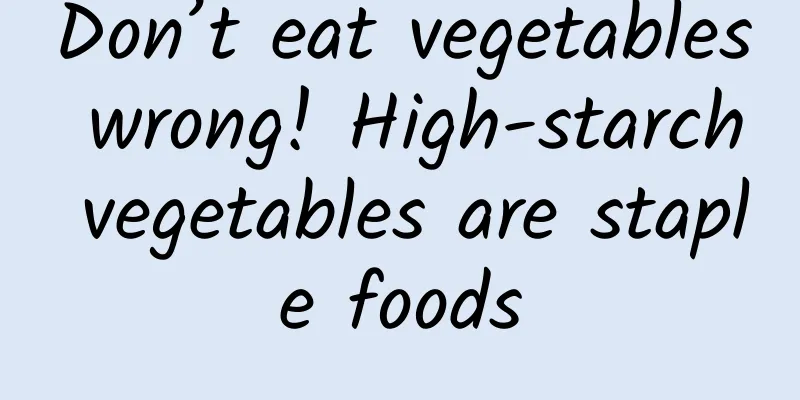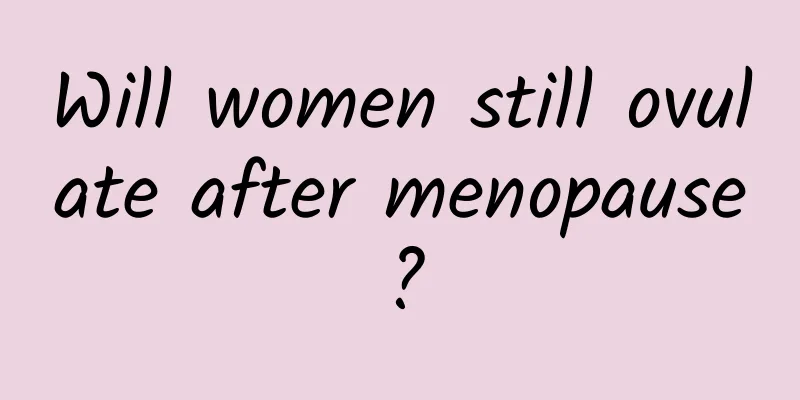Don’t eat vegetables wrong! High-starch vegetables are staple foods

|
First, clarify which vegetables belong to whole grains and root vegetables, which are high-starch vegetables rather than the high-fiber, low-calorie vegetables as people think, so that you don't gain weight by eating more vegetables. It turns out not all plants are vegetables! From a nutritional point of view, "vegetables" are plants that contain only 5 grams of sugar per 100 grams, which are the real vegetables. Many vegetables that the general public considers to be vegetables, such as corn, pumpkin, etc., are not actually considered true vegetables in the eyes of nutritionists. Instead, they are starchy vegetables that can be used as staple foods, and starch is a type of sugar. Nutritionist Chen Yunfan said that for people who want to control their weight, the first thing to control from a dietary perspective is the total amount of sugar they eat. Therefore, they must clearly know which foods are high in sugar, and then control the intake of staple starch foods (such as rice and noodles); at the same time, don't forget that high-starch vegetables (such as corn) must also be consumed in moderation because they are high in starch and sugar; other foods such as fructose in fruits and lactose in milk must all be calculated when controlling sugar intake; in addition, foods containing refined sugars, such as cakes, candies, etc., should be eaten as little as possible or even not eaten. Clarifying the difference between staple food starch and vegetable starch Especially high-starch vegetables are more easily overlooked. Therefore, when there are high-starch vegetables in the diet, you must choose between them and the original staple starch foods such as rice, or reduce the intake of both. That is, if there are side dishes such as corn and peas in the meal, the amount of rice or noodles should be reduced. Only by such substitution can the total starch intake be controlled. But most people think that only staple starchy foods are high in sugar, so they eat the rest of the food without restraint, which can easily lead to the embarrassing situation of getting fatter the more they lose weight. First of all, we must clarify which vegetables are whole grains and root vegetables that are high in starch, rather than the high-fiber, low-calorie vegetables as we think. This is because these high-starch vegetables are often the most easily overlooked by those who want to control their weight. They are always considered to be vegetables with high nutritional value, and they do not know how to control the amount of consumption. The starchy vegetables that are most easily overlooked include sweet potatoes, taro, corn, pea kernels (green beans), broad beans (emperor beans), chestnuts, water chestnuts, etc. Autumn and winter are the production seasons of chestnuts and water chestnuts. Many people often eat sugar-fried chestnuts and boiled water chestnuts as snacks, but they don’t know that by slurping them one bite after another, they unknowingly eat all the starch ingested from a portion of staple food into their stomachs. Then, if they don’t reduce the amount of rice or noodles at mealtime, their weight will really increase. Common high-starch vegetables 【corn】: Corn, a common ingredient on the dining table, is a great side dish for meals. Whether it is corn kernels in egg fried rice, corn segments in pork ribs soup, or even grilled sweet corn in a hamburger meal, it is not only beautiful in color but also delicious in taste. In addition to containing 100 calories per 100 grams, it is also rich in lutein and carotenoids, which are very helpful for maintaining eye vision. In addition, it also contains trace elements such as potassium and phosphorus and high dietary fiber, which can help the body's metabolism. Pay special attention to emerging varieties on the market, including glutinous rice corn, sweet corn, and fruit corn, which are also high-starch vegetables and should be consumed in moderation. 【Pea kernels (green peas)】: Pour the stir-fried shrimp and green beans with starch over white rice and you can eat a whole plate of it right away, or pair it with pumpkin soup garnished with some pea kernels to whet your appetite and you can drink several bowls of it at once. 100 grams of pea kernels have 166 calories and are high in dietary fiber and starch. They also contain vitamin C and beta-carotene, which can effectively fight free radicals and increase the whitening and anti-aging effects. Fresh broad beans fried with shredded pork or made into broad bean crispy snacks suitable for all ages are very popular. They are also high-starch vegetables, with 109 calories per 100 grams. They are rich in protein and amino acids, but they contain allergenic ingredients. People with sensitive constitutions should be especially careful when eating them, as favism is common. Edamame is not a high-starch vegetable. 【potato】: French fries, hash browns, or potato wedges in curry rice sauce in a fast food hamburger meal are all delicious and often make people salivate. But 100 grams of potatoes contain 76 calories. The nutritional value of starch is high. Although it also contains vitamin C and potassium, which can protect blood vessels and lower blood pressure, due to the high starch content, it must be consumed as a staple starch food to avoid taking in too many calories. As for sweet potatoes, which are regarded as a holy product for health preservation and weight loss, whether it is ordinary sweet potatoes, red sweet potatoes, or chestnut sweet potatoes, although they are rich in dietary fiber, they also have high starch and sugar content, with 85 calories in 100 grams. If you want to eat sweet potatoes, remember to replace or reduce the staple food of rice and noodles so that you don't get fatter and fatter. 【Taro】: The stir-fried taro shreds with green onions are delicious when paired with hot white rice, or the braised taro from Taiwanese Shandong cuisine is also delicious. Whether it is betel nut taro, red stem taro..., every 100 grams of taro has 128 calories. Although it is a high-dietary fiber food that can prevent constipation and improve bowel problems, it should be classified as a staple starch food in terms of consumption due to its high starch and protein content. 【pumpkin】: The fragrant creamy pumpkin soup often makes people unable to resist drinking several bowls. The steamed pumpkin puree is made into a salad with mayonnaise and is quite delicious. However, pumpkin is also a high-starch vegetable, with 70 calories per 135 grams. It is rich in vitamins and minerals. It is recommended to add some oil when cooking so that the carotenoids contained in the pumpkin can be absorbed by the human body. 【Yam】: In the cold winter, drink a bowl of yam and chicken soup to warm your body. Grind fresh yam into paste and mix it with hot white rice. The standard Japanese rice bowl is delicious. However, 100 grams of yam contains 66 calories and is a starchy ingredient. The special taste of yam is due to the mucus protein, so the protein content is relatively high (2.4 grams of protein per 100 grams), which can increase blood vessel elasticity and promote blood circulation. Because it contains estrogen, excessive consumption will affect hormone secretion. In addition, it is a high-starch vegetable, so if you eat a little more, the calories will exceed the limit. As for purple yam, which has a different color and taste, its nutritional value is also quite high, but its main ingredient is still starch, so like yam, it must be consumed in moderation. Lotus root: Lotus root is most often cooked with pork ribs into soup, which can moisturize the stomach and intestines. Some people stuff the holes of the lotus root with glutinous rice and steam it to make a light-tasting delicacy. However, lotus root, a starchy vegetable, plus rice is just starch with starch. Every 100 grams of lotus root contains 74 calories, vitamin C and high dietary fiber. It is also a root food with a higher iron content. It is very helpful for people with hypoxic anemia, but be careful of the sudden increase in starch content. As for the lotus seeds in the Four Gods Soup and the dessert White Fungus and Lotus Seeds, they are also ingredients with high starch content and should be consumed in moderation to avoid exceeding the calorie limit. 【chestnut】: The aroma wafting from the street-side sugar-roasted chestnut stalls or the sweet chestnuts wrapped in rice dumplings are all appetizing. 100 grams (about 12 pieces) of chestnuts contain 148 calories and are high in protein and unsaturated fatty acids, which are very helpful to human health. From the perspective of traditional Chinese medicine, they have the effects of nourishing the stomach and spleen, promoting blood circulation and stopping bleeding. However, chestnuts are high-starch vegetables and the intake must be controlled. 【water chestnut】: Steamed water chestnuts are delicious even without any seasoning. People often eat a whole bag of them at a time. There are also dishes such as water chestnut oil rice. However, as water chestnuts are high-starch vegetables, the amount you eat should be limited so as not to consume too many calories. 100 grams contains 140 calories and is rich in starch, protein and vitamins. It is a very good healthy food for those who are weak or want to strengthen their bodies. Patients with diabetes and kidney disease should pay special attention Nutritionist Song Minghua explained that according to the common calorie calculation method, the calories in 100 grams of vegetables are about 20 to 30 calories, but the calories in 100 grams of corn kernels are nearly 100 calories. The calories in this type of high-starch vegetables are 3 to 4 times that of ordinary vegetables. If these high-starch whole-grain root vegetables are consumed as ordinary vegetables, the calories will easily exceed the limit. Especially diabetic patients must pay special attention, because diabetic patients must control the sugar intake in their diet. Doctors will also specifically instruct diabetic patients to eat more vegetables to balance blood sugar, but they must not ignore the high sugar content of these high-starch vegetables. If they consume too much while mistakenly thinking that they are low-sugar vegetables, it will affect blood sugar control. In addition, patients with kidney disease must control their intake of potassium ions in minerals. The aforementioned foods all contain relatively high levels of potassium ions, so special attention must be paid to the amount when consuming them. Do not eat too much, which would cause excessive potassium ions in the blood and cause physical discomfort. Pay attention to controlling blood sugar! The glycemic index of high-starch vegetables is not low. The rate at which blood sugar rises in the body after ingesting food is the glycemic index (GI for short). The higher the glycemic index of a food, the faster blood sugar rises after ingestion, which is not conducive to blood sugar control. Generally, foods with a GI value greater than 60 are considered high GI foods. For example, 100 grams of corn has 100 calories and a GI value of over 60, which is a high GI food. The high-starch vegetables mentioned in this article, including taro, potato, chestnut, yam, pumpkin, etc., are also high GI foods. People who control their blood sugar should pay attention to this. [For the full content, please see Changchun Monthly Issue 394] |
<<: Fat terminator! Enoki mushroom ice cubes are great in cooking
>>: Are potatoes a good helper for weight loss? The key is the cooking method
Recommend
Low-calorie New Year dishes are good for your health! If you have a bad stomach, try "Yam Stewed Sea Bass"
The temperature is relatively low in winter. Peop...
How to test yourself whether you are born without vagina
Many women do not know their own physiological st...
Pelvic peritonitis infection route
Experts say that pelvic peritonitis is a type of ...
What are the symptoms of pelvic inflammatory disease?
Pelvic inflammatory disease is a female gynecolog...
Reverse aging! 8 nutrients you must eat to fight aging
Aging is a natural process, but why do some peopl...
Lemons high in nobiletin help improve metabolism
Modern people pay attention to health and wellnes...
You tap the gallbladder meridian every day, but edema still occurs frequently? If you neglect to pay attention to the details, the effect of reducing edema will be halved!
You tap the gallbladder meridian every day but yo...
How to properly care for cervical precancerous lesions after surgery
Cervical precancerous lesions are a disease that ...
Is cervicitis contagious in women? Common knowledge about cervicitis that women must know
Is cervicitis contagious? This is a question ofte...
What is the surgical plan for uterine fibroids? What are the surgical indications for uterine fibroids?
What is the surgical plan for uterine fibroids? W...
How to check for endometrial tuberculosis
The incidence of endometrial tuberculosis is now ...
What are the symptoms of cervicitis
The symptoms of cervicitis mainly include increas...
The main nursing issues of hyperprolactinemia
Regarding the nursing measures for hyperprolactin...
What are the main causes of cervical hypertrophy in women?
Cervical hypertrophy is also a type of female gyn...
What are the classifications of uterine fibroids? Can I still get pregnant after removing uterine fibroids?
Clinically, it is found that many people panic af...









